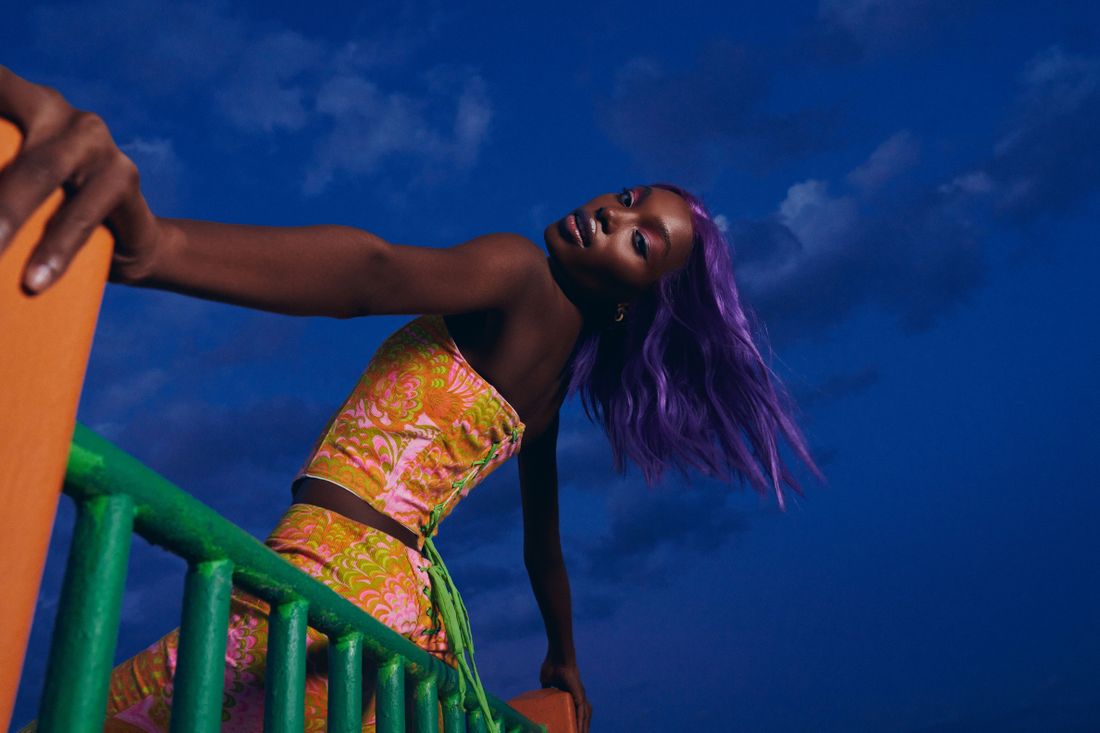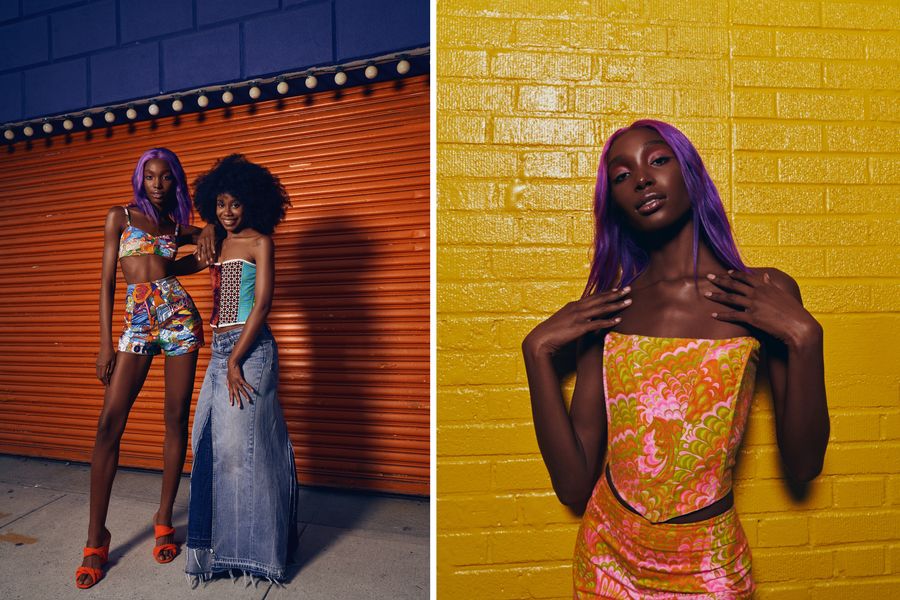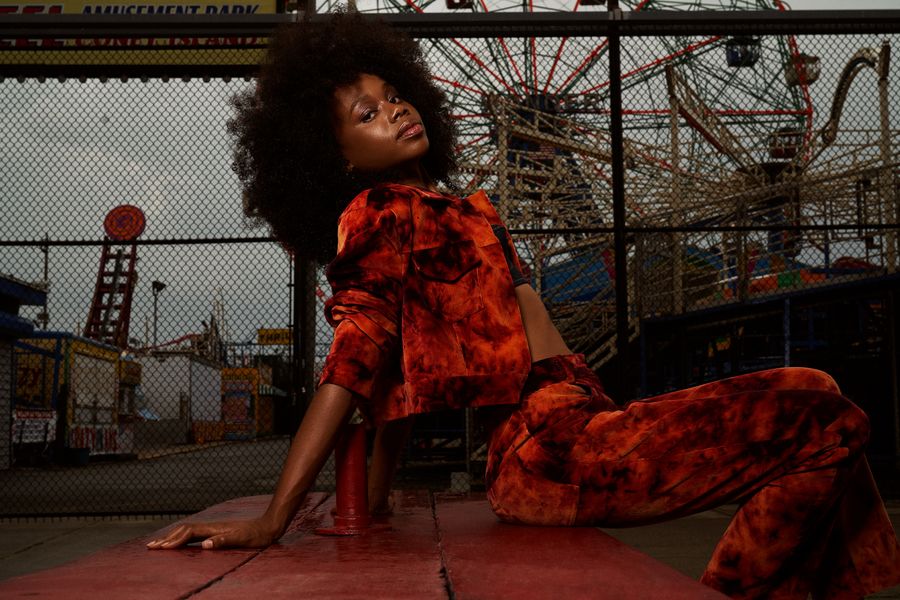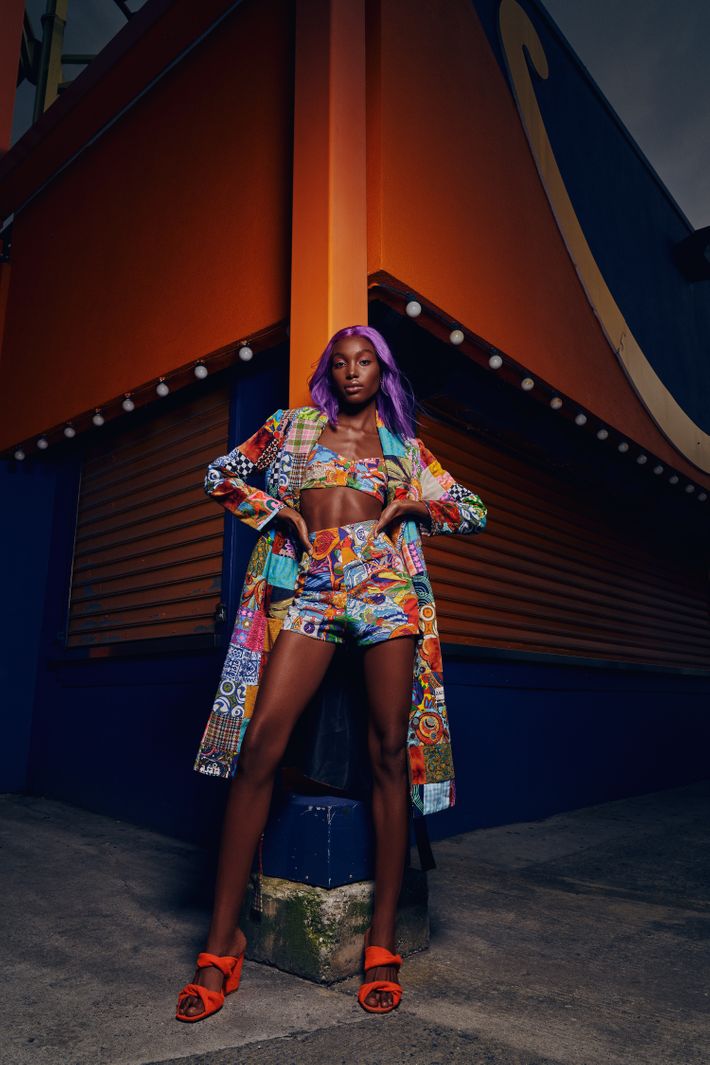
Asata Maisé describes her current design aesthetic as “a frivolous nod to the past” — a vibe that feels especially refreshing right now, when the present is frequently exhausting. The Delaware-born designer’s clothes are eccentric and playful, referencing psychedelia, California surf culture, and classic movies. After seeing Shirley MacLaine’s What a Way to Go!, for example, she became obsessed with ‘50s and ‘60s details and silhouettes, a fixation that resulted in pieces like terrycloth bucket hats and smiley-face shoulder bags. Her use of recycled fabrics make her project feel extra nostalgic — a sustainable trip back in time.
Reworked clothing has been trending during quarantine, with brands like urbn rewrrk, JJVintage, and Frankie Collective Vintage providing the more conscious shopper with go-to custom pieces at reasonable prices. From the materials to the silhouettes, Asata Maisé is taking reworking to the next level: She is not only a designer — she also makes, photographs, and models most of her work. At 27, she’s tapping into fashion history in a way that feels entirely modern.
Maisé knew she wanted to be an artist from a young age. She had dreams of becoming a pastry chef, but after the cooking class she took in high school turned out to be disappointing, she switched into a textiles-and-clothing course for her required “career pathways” extracurricular. Even though she joined the class a full month late, Maisé’s teacher immediately saw her natural ability to design and sew. Soon, she was debuting her work in a local fashion show. She was 16 years old.
“I had a headache that whole day,” says Maisé. “I was always super-small and shy, so I was sitting in the farthest corner in the back with all of this chaos going on around me. None of the models fit my clothes because I made all my clothes fit me, and I’m super petite. It was a nightmare and I was freaking. My mom came backstage and asked someone to point her to the farthest corner because she knew I would be there, and she helped me calm down and regroup myself. We finally found someone who could fit into everything, and people loved my clothes. That was when I knew I wanted to be a fashion designer.”
Maisé initially sourced her materials from Etsy just because she wanted one-of-a-kind fabric. Her recent collection, for example, includes a 1950s-style playsuit made in a rare nautical print from the 1960s. But the waste, pollution, and abusive labor practices of fast fashion all drove her to begin using secondhand fabrics and textiles exclusively. “I was following someone on Etsy who had a lot of fabric, and that’s where it started. There is so much waste and byproducts that come from the textile industry; it was nicer for me — in my head — to purchase something that was already there [and] to support someone who had a small business,” says Maisé.
With her eyes on the goal, Maisé attended Albright College to further her design education. But after having spent all of high school learning from a teacher with 40 years of garment-construction experience, she felt like Alrbight’s fashion program was a step backward. The lack of challenge on top of the high cost of tuition led her to drop out after one semester. She impulsively moved to Los Angeles, where she got a full-time job at Nobu Malibu to pay the bills and gained experience working for different designers.
A few years into her L.A. experiment, Maisé felt it was time to focus on developing her label, so she launched a shop on Depop. She sold a mix of vintage designer pieces as well as her own designs, which included menswear. Slowly, she began to grow her fanbase. Last December, Maisé moved to New York City to try to get more exposure for her work but quickly realized she wanted to apply for the CFDA/Vogue fashion fund.
With only three months to make a new collection, Maisé quit her job and moved back into her mom’s house in Delaware in order to focus on the application process — and then the pandemic hit. “That changed everything. The CFDA/Vogue Fashion Fund decided to not go with the same process this year. They changed it to ‘A Common Thread,’ and I didn’t qualify for that funding because it looks like I make no money as a business, especially prior to this year. I was bummed out.”
Still, she found ways to support her work. Being featured on Vogue’s list of Black-owned fashion and beauty brands to support now and always helped her increase her Instagram following from 1,000 to 14,000 within a couple of weeks. In June, pop singer Halsey announced she was launching her Black Creators Fund Initiative to provide resources, funding, and a platform for Black artists. In the first round, Halsey chose ten recipients; Maisé was among the top five. With the funds she received, Maisé was able to invest in her first studio, add a member to her one-woman team, and fully dive into growing her two-year-old clothing brand.
Watching the project finally take off is overwhelming, says Maisé. “I’m super grateful because this is everything I’ve worked so hard for the past ten years of my life,” she says, with real emotion in her voice. “It gets you down when you feel like nothing’s changing. I felt like I’d been working hard and making cool clothes, but no one was seeing it. Then it finally took off. And obviously for certain reasons,” says Maisé, referring to the hypervisibility of Black creatives right now.
Maisé believes up-and-coming designers, including herself, have two roles to play in changing the fashion industry: They have to keep their vision authentic, but they also have to educate their audience. “I want to continue staying true to myself in what I create because it inspires other people. But I also want to make people aware of what goes on behind everything they consume,” says Maisé. “If you get down to the nitty gritty of these big brands and corporations, a lot of people are being underpaid. They aren’t credited — and then there’s the pollution and waste. If I can play any part in breaking away from that, I’ll be very grateful.”







